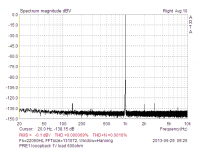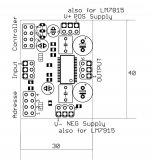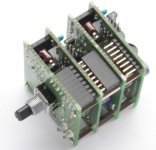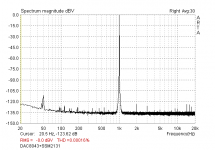Reason is simple, it is more comfortable , more convenient for remote control, it is simple to add some functions (eg. balance control, or sensitvity adjustment for each input -simple change in control program, I used it 14 years ago), without added costs. And for sound - "it is enough"..So why do it better and more complicated?😉
For sure they know how to do it better. And I know it, too, example in attachment..Whole preamp, 1V RMS output in 600ohm load. No harmonics higher than third..
Attachments
Anyway, as everything in life there are many compromises and many tastes involved. However, an integrated electronic pot of small footprint and easy construction costing lets say 30-50€ (wild guess based on Japanese offering) will be amazingly better than any other offering at the price (but maybe not constrained to) and excellent for experimentation and integration in our current and future diy projects. I would easily buy 10 units. Moreover, if somebody wants to get fancy, it can be done modular having provision for an external display and remote control too.
Just my 2c
You are looking for something like this.
That's cooking for some time
Muses Modular:
stackable up to 8 units or more for multichannel with one external single controller
PADS for input and output
+/-18V header, or install a 78/7915 on the same header
5V Bias for Muses on board
Controller in the same size ore smaller with one board 5V regulator ,without display
rotary encoder or normal potentiometer
IR Receiver
Header for serial interface to configure offset for multichannel and active speaker systems.
learning IR control
Attachments
... For sure they know how to do it better. And I know it, too, example in attachment..Whole preamp, 1V RMS output in 600ohm load. No harmonics higher than third..
Hello and sorry to jump in but the graph is astonishing.
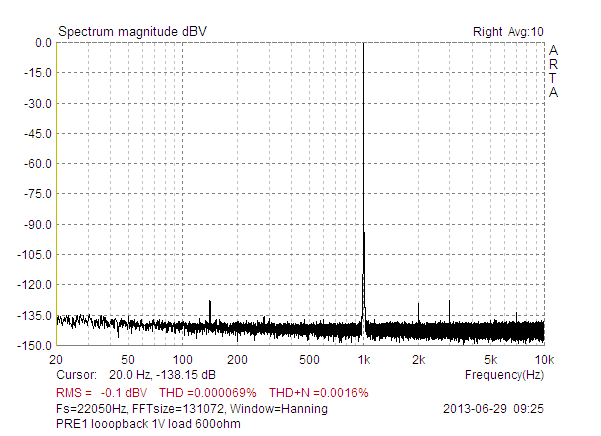
I have never seen something like this.
Could you give me some more info on the unit with this performance ?
Is it a line stage ? I am very curious
Thanks a lot and kind regards,
gino
Last edited:
You are looking for something like this.
That's cooking for some time
Muses Modular:
stackable up to 8 units or more for multichannel with one external single controller
PADS for input and output
+/-18V header, or install a 78/7915 on the same header
5V Bias for Muses on board
Controller in the same size ore smaller with one board 5V regulator ,without display
rotary encoder or normal potentiometer
IR Receiver
Header for serial interface to configure offset for multichannel and active speaker systems.
learning IR control
Yep thats it! Although I would prefer for simplicity and compactness the controller to be on board as in the Japanese configuration I posted earlier, I really think its very doable and desirable too!
Yep thats it! Although I would prefer for simplicity and compactness the controller to be on board as in the Japanese configuration I posted earlier, I really think its very doable and desirable too!
I've been thinking about the controller on board, but for modular applications (e.g. 2 times for balanced ) it is better to get only one controller to the front.
That costs a little more, but it gives you more options for the mechanical integration.
I've been thinking about the controller on board, but for modular applications (e.g. 2 times for balanced ) it is better to get only one controller to the front.
That costs a little more, but it gives you more options for the mechanical integration.
Yep i quite agree, as below
Link
Another Japanese build.
Attachments
Last edited:
Yep i quite agree, as below
Another Japanese build.
Nice and tidy! This is exactly what I had in mind Jap simplicity & creativity!
Hmmm I guess I realy have to contact my pic programmer as I already started the pcb this morning and going to finish that tonight! It is alot easier than initially anticipated!
BV,
as somebody stated later, that's a very impressive plot.
if you don't mind, please say more about how it was achieved, other than not using a digital based volume control.
thanks,
mlloyd1
as somebody stated later, that's a very impressive plot.
if you don't mind, please say more about how it was achieved, other than not using a digital based volume control.
thanks,
mlloyd1
.... And I know it, too, example in attachment..Whole preamp, 1V RMS output in 600ohm load. No harmonics higher than third..
Measurement is on whole preamp, balanced line in (1V RMS), balanced out loaded with 600ohm , relay attenuator regulation (impedance 1k), all discrete bipolar stages (balanced input, gain stage, relay regulation, balanced/unbalanced out, modular blocks.please say more about how it was achieved
I used more than 10years similar circuits like MUSES, but it is realy limited only to "midfi". Best results obtained with CMOS DAC in multiplying mode. But relays are way better..
The measurements are really great! And when it sounds good, then congratulations.
But if you have used similar like the muses, then you have just not tried muses.
I can not understand what makes the muses ' midfi ' for you. The data sheet and the measurements .
And what is now "midfi"? What do we need for Hi-Fi?
Good sounding compromises, because that is what we will ever get.
But if you have used similar like the muses, then you have just not tried muses.
I can not understand what makes the muses ' midfi ' for you. The data sheet and the measurements .
And what is now "midfi"? What do we need for Hi-Fi?
Good sounding compromises, because that is what we will ever get.
Spiri, best for me is, if it does not sound (without any "footprint"), so it is also my personal border between hifi and midfi. I am looking for best possible results without "unobtainium" components.
Similar like MUSES means the same concept, on chip resistors, with integrated switches (WM8816, PGA..). Limitation are inherent for MUSES, too. It is clearly visible from measuremets. Relays are "quasiperfect" .. It is clearly visible from measurements.
Similar like MUSES means the same concept, on chip resistors, with integrated switches (WM8816, PGA..). Limitation are inherent for MUSES, too. It is clearly visible from measuremets. Relays are "quasiperfect" .. It is clearly visible from measurements.
Last edited:
You can do it a lot better 🙂.That's what I did
Attachments
I need better measuring equipment first, my graphs are at the limit of the THD I can measure 🙁You can do it a lot better 🙂.
Since the MUSES setup from Academy Audio also requires 5VDC, is there a simple way to get this from a +-15VDC supply or should one get a separate transformer and regulator for the 5V?
Thanks...
Thanks...
for the MUSES Vdd while they don't seem to spec the Vdd current it looks like it has to be very small - they show ~250 kOhm internal load, call out 10 kOhm external series R for protection in the application circuit example
so deriving 5 V from V+/- analog supplies should be easy
the uC, other digital circuitry you need can be very low power with many of today's parts
so deriving 5 V from V+/- analog supplies should be easy
the uC, other digital circuitry you need can be very low power with many of today's parts
Last edited:
so deriving 5 V from V+/- analog supplies should be easy
OK, so exactly how can I get 5V from the 15V supplies? I'm looking for an example circuit since I don't have a clue how to do it.
So no one knows a simple way to get a 5V supply from a 15V supply or if the circuit i posted above is sufficient??
Interesting...
Interesting...
Would this circuit work okay for the 5V supply minus the transformer and rectifier?
I read that it uses a pi-filter and good for digital applications.
Thats ok.
You can copy the schematic from our data sheets . (see links)
Our Muses board has a 5V regulator only for biasing the muses.
The controller and the relays are powered with a separate 7805 regulator
If you don't like to generate the digital voltage for the muses from the positiv analog voltage, make sure that there is a 10 kOhm in the DVDD line - pin 17.
Attachments
- Home
- Source & Line
- Analog Line Level
- MUSES 72320 electronic volume
